- Sample Business Plans
- Transportation, Logistics & Travel

Logistics Business Plan
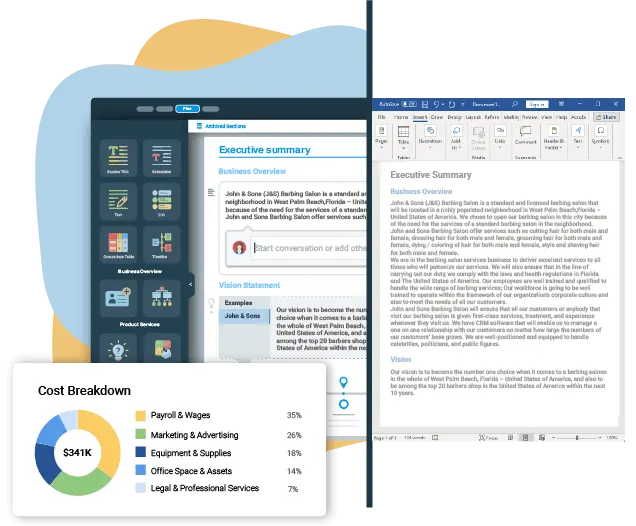
Both literally and symbolically, logistics businesses are the wheels of the whole global economy. As commodities go from supplier to customer, the transportation and logistics industry plays a crucial role in maintaining the American economy. So, the industry is as rewarding as important.
Need help writing a business plan for your logistics business? You’re at the right place. Our logistics business plan template will help you get started.
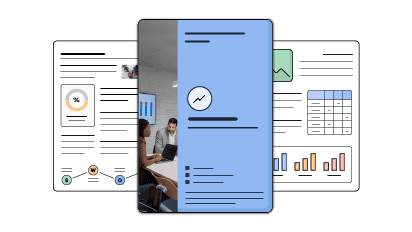
Free Business Plan Template
Download our free logistics business plan template now and pave the way to success. Let’s turn your vision into an actionable strategy!
- Fill in the blanks – Outline
- Financial Tables
How to Write a Logistics Business Plan?
Writing a logistics business plan is a crucial step toward the success of your business. Here are the key steps to consider when writing a business plan:
1. Executive Summary
An executive summary is the first section planned to offer an overview of the entire business plan. However, it is written after the entire business plan is ready and summarizes each section of your plan.
Here are a few key components to include in your executive summary:
- Introduce your business: Start your executive summary section by briefly introducing your business to your readers. This section may include the name of your logistics business, its location, when it was founded, etc.
- Market opportunity: Summarize your market research, including market size, growth potential, and marketing trends. Highlight the opportunities in the market and how your business will fit in to fill the gap.
- Logistics services: Highlight the logistics services you offer your clients. The USPs and differentiators you offer are always a plus. For instance, you may include transportation, distribution, warehousing, packaging, etc.
- Management team & sales strategies: Outline your sales and marketing strategies—what marketing platforms you use, how you plan on acquiring customers, etc.
- Financial highlights: Briefly summarize your financial projections for the initial years of business operations. Include any capital or investment requirements, associated startup costs, projected revenues, and profit forecasts.
- Call to action: Summarize your executive summary section with a clear CTA, for example, inviting angel investors to discuss the potential business investment.
Ensure your executive summary is clear, concise, easy to understand, and jargon-free.
Say goodbye to boring templates
Build your business plan faster and easier with AI
Plans starting from $7/month

2. Business Overview
The business overview section of your business plan offers detailed information about your company. The details you add will depend on how important they are to your business. Yet, business name, location, business history, and future goals are some of the foundational elements you must consider adding to this section:
- Business Description: Describe your business in this section by providing all the basic information:
- Freight forwarding: These companies transport goods from one place to another for big companies.
- Heavy haulage logistics: These types of companies specialize in transporting heavy goods.
- Courier and delivery services: They deliver goods at local and regional levels for companies and individuals.
- Reverse logistics: These businesses are experts at handling the processes involved in sending products back to the manufacturer from the client.
- Describe the legal structure of your logistics company, whether it is a sole proprietorship, LLC, partnership, or others.
- Explain where your business is located and why you selected the place.
- Ownership: List the names of your logistics company’s founders or owners. Describe what shares they own and their responsibilities for efficiently managing the business.
- Mission statement: Summarize your business’ objective, core principles, and values in your mission statement. This statement needs to be memorable, clear, and brief.
- Business history: If you’re an established logistics service provider, briefly describe your business history, like—when it was founded, how it evolved over time, etc.
- Additionally, If you have received any awards or recognition for excellent work, describe them.
- Future goals: It’s crucial to convey your aspirations and vision. Mention your short-term and long-term goals; they can be specific targets for revenue, market share, or expanding your services.
This section should provide a thorough understanding of your business, its history, and its future plans. Keep this section engaging, precise, and to the point.
3. Market Analysis
The market analysis section of your business plan should offer a thorough understanding of the industry with the target market, competitors, and growth opportunities. You should include the following components in this section.
- Target market: Start this section by describing your target market. Define your ideal customer and explain what types of services they prefer. Creating a buyer persona will help you easily define your target market to your readers.
- For instance, if you own a reverse logistics type, then you need to choose the location where people buy products mostly online.
- Market size and growth potential: Describe your market size and growth potential and whether you will target a niche or a much broader market.
- Competitive analysis: Identify and analyze your direct and indirect competitors . Identify their strengths and weaknesses, and describe what differentiates your logistics services from them. Point out how you have a competitive edge in the market.
- Market trends: Analyze emerging trends in the industry, such as technology disruptions, changes in customer behavior or preferences, etc. Explain how your business will cope with all the trends.
- Regulatory environment: List regulations and licensing requirements that may affect your logistics company, such as business registration, insurance, environmental regulations, state and federal regulations, etc.
Here are a few tips for writing the market analysis section of your logistics business plan:
- Conduct market research, industry reports, and surveys to gather data.
- Provide specific and detailed information whenever possible.
- Illustrate your points with charts and graphs.
- Write your business plan keeping your target audience in mind.
4. Products And Services
The product and services section should describe the specific services and products that will be offered to customers. To write this section should include the following:
- Transportation
- Warehousing
- Distribution
- Freight forwarding
- Customs brokerage
- Packaging and crating
- Tracking and monitoring, and any other services you plan to offer
- Describe each service: Provide a detailed description of each service you provide, including the process involved, and the time required.
- Additional Services: Mention if your logistics company offers any additional services. You may include services like packaging, online booking, etc.
- Quality control: To ensure that products are handled safely and effectively, describe your quality control methods. Indicate how you’ll uphold quality standards for inventory management, shipping, and storage as part of the logistics process.
In short, this section of your logistics plan must be informative, precise, and client-focused. By providing a clear and compelling description of your offerings, you can help potential investors and readers understand the value of your business.
5. Sales And Marketing Strategies
Writing the sales and marketing strategies section means a list of strategies you will use to attract and retain your clients. Here are some key elements to include in your sales & marketing plan:
- Unique selling proposition (USP): Define your business’s USPs depending on the market you serve, the equipment you use, and the unique services you provide. Identifying USPs will help you plan your marketing strategies.
- For example, excellent customer service, timely delivery, packaging, etc.
- Pricing strategy: Describe your pricing strategy—how you plan to price your logistics services and stay competitive in the local market. You can mention any discounts you plan on offering to attract new customers to your service.
- Marketing strategies: Discuss your marketing strategies to market your services. You may include some of these marketing strategies in your business plan—social media marketing, brochures, email marketing, and print marketing.
- Sales strategies: Outline the strategies you’ll implement to maximize your sales. Your sales strategies may include how to generate leads, qualify prospects, and close deals.
- Customer retention: Describe your customer retention strategies and how you plan to execute them. For instance, introducing discounts on annual membership, personalized service, etc.
Overall, this section of your logistics business plan should focus on customer acquisition and retention.
Have a specific, realistic, and data-driven approach while planning sales and marketing strategies for your logistics business, and be prepared to adapt or make strategic changes in your strategies based on feedback and results.
6. Operations Plan
The operations plan section of your business plan should outline the processes and procedures involved in your business operations, such as staffing requirements and operational processes. Here are a few components to add to your operations plan:
- Staffing & Training: Mention your business’s staffing requirements, including the number of employees like operations manager, driver, dispatcher, etc. Include their qualifications, the training required, and the duties they will perform.
- Operational process: Outline the processes and procedures you will use to run your logistics business. Your operational processes may include sending quotations, scheduling appointments, transportation, handling deliveries, etc.
- Equipment & Machinery: Describe the hardware and software needed, such as logistics software systems, warehouse equipment, and vehicles, to carry out your logistics activities. Tell us how the technology will be improved, maintained, and acquired.
Adding these components to your operations plan will help you lay out your business operations, which will eventually help you manage your business effectively.
7. Management Team
The management team section provides an overview of your logistics business’s management team. This section should provide a detailed description of each manager’s experience and qualifications, as well as their responsibilities and roles.
- Founders/CEO: Mention the founders and CEO of your logistics company, and describe their roles and responsibilities in successfully running the business.
- Key managers: Introduce your management and key members of your team, and explain their roles and responsibilities.
- It should include, key executives(e.g. COO, CMO.), senior management, and other department managers including their education, professional background, and any relevant experience in the industry.
- Organizational structure: Explain the organizational structure of your management team. Include the reporting line and decision-making hierarchy.
- Compensation plan: Describe your compensation plan for the management and staff. Include their salaries, incentives, and other benefits.
- Advisors/consultants: Mentioning advisors or consultants in your business plans adds credibility to your business idea.
- So, if you have any advisors or consultants, include them with their names and brief information consisting of roles and years of experience.
This section should describe the key personnel for your logistics services, highlighting how you have the perfect team to succeed.
8. Financial Plan
Your financial plan section should provide a summary of your business’s financial projections for the first few years. Here are some key elements to include in your financial plan:
- Profit & loss statement: Create a projected profit & loss statement that describes the expected revenue, cost of products sold, and operational costs. Your spa’s anticipated net profit or loss should be computed and included.
- Cash flow statement: The cash flow for the first few years of your operation should be estimated and described in this section. This may include billing invoices, payment receipts, loan payments, and any other cash flow statements.
- Balance sheet: Create a projected balance sheet documenting your business’s assets, liabilities, and equity.
- Break-even point: Determine and mention your business’s break-even point—the point at which your business costs and revenue will be equal.
- This exercise will help you understand how much revenue you need to generate to sustain or be profitable.
- Financing needs: Calculate costs associated with starting a logistics business, and estimate your financing needs and how much capital you need to raise to operate your business. Be specific about your short-term and long-term financing requirements, such as investment capital or loans.
Be realistic with your financial projections, and make sure you offer relevant information and evidence to support your estimates.
9. Appendix
The appendix section of your plan should include any additional information supporting your business plan’s main content, such as market research, legal documentation, financial statements, and other relevant information.
- Add a table of contents for the appendix section to help readers easily find specific information or sections.
- In addition to your financial statements, provide additional financial documents like tax returns, a list of assets within the business, credit history, and more.These statements must be the latest and offer financial projections for at least the first three or five years of business operations.
- Provide data derived from market research, including stats about the industry, user demographics, and industry trends.
- Include any legal documents such as permits, licenses, and contracts.
- Include any additional documentation related to your business plan, such as product brochures, marketing materials, operational procedures, etc.
Use clear headings and labels for each section of the appendix so that readers can easily find the necessary information.
Remember, the appendix section of your logistics business plan should only include relevant and important information supporting your plan’s main content.
The Quickest Way to turn a Business Idea into a Business Plan
Fill-in-the-blanks and automatic financials make it easy.
This logistics company business plan will provide an idea for writing a successful plan, including all the essential components of your business.
After this, if you still need clarification about writing an investment-ready business plan to impress your audience, download our logistics business plan pdf .
Related Posts
400+ Sample Business Plans Template
Business Plan Writing Process
Business Plan Cover Page Designing Guide
Frequently Asked Questions
Why do you need a logistics business plan.
A business plan is an essential tool for anyone looking to start or run a successful logistics business. It helps to get clarity in your business, secures funding, and identifies potential challenges while starting and growing your business.
Overall, a well-written plan can help you make informed decisions, which can contribute to the long-term success of your logistics company.
How to get funding for your logistics business?
There are several ways to get funding for your logistics business, but self-funding is one of the most efficient and speedy funding options. Other options for funding are:
- Bank loan – You may apply for a loan in government or private banks.
- Small Business Administration (SBA) loan – SBA loans and schemes are available at affordable interest rates, so check the eligibility criteria before applying for it.
- Crowdfunding – The process of supporting a project or business by getting a lot of people to invest in your business, usually online.
- Angel investors – Getting funds from angel investors is one of the most sought startup options.
Apart from all these options, there are small business grants available, check for the same in your location and you can apply for it.
Where to find business plan writers for your logistics business?
There are many business plan writers available, but no one knows your business and ideas better than you, so we recommend you write your logistics business plan and outline your vision as you have in your mind.
What is the easiest way to write your logistics business plan?
A lot of research is necessary for writing a business plan, but you can write your plan most efficiently with the help of any logistics business plan example and edit it as per your need. You can also quickly finish your plan in just a few hours or less with the help of our business plan software.
About the Author
Upmetrics Team
Upmetrics is the #1 business planning software that helps entrepreneurs and business owners create investment-ready business plans using AI. We regularly share business planning insights on our blog. Check out the Upmetrics blog for such interesting reads. Read more

Turn your business idea into a solid business plan
Explore Plan Builder
Plan your business in the shortest time possible
No Risk – Cancel at Any Time – 15 Day Money Back Guarantee

Create a great Business Plan with great price.
- 400+ Business plan templates & examples
- AI Assistance & step by step guidance
- 4.8 Star rating on Trustpilot
Streamline your business planning process with Upmetrics .


Logistics Business Plan Template
Written by Dave Lavinsky
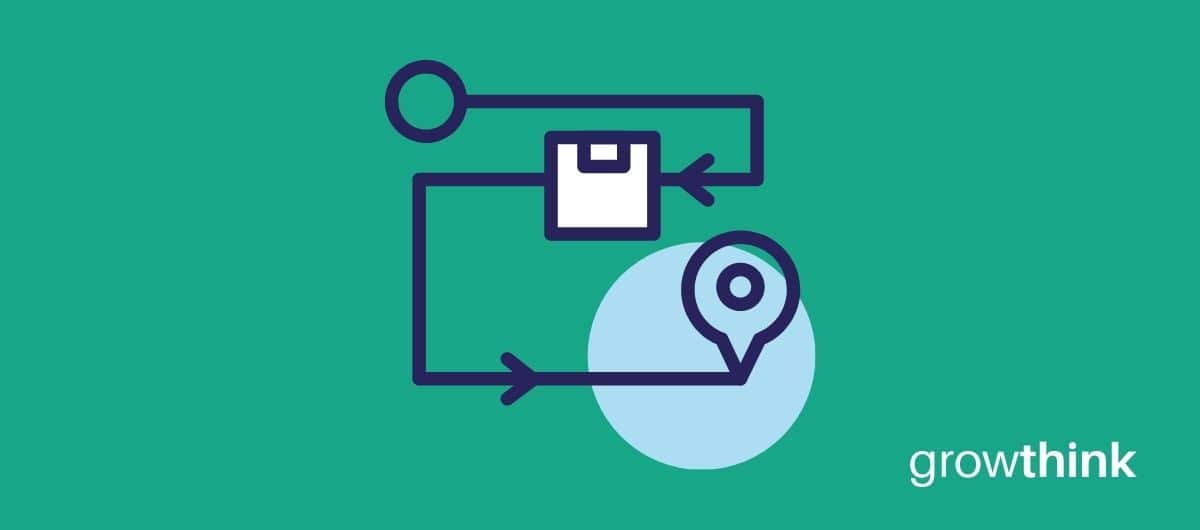
Logistics Business Plan
Over the past 20+ years, we have helped over 500 entrepreneurs and business owners create business plans to start and grow their logistics companies.
If you’re unfamiliar with creating a logistics business plan, you may think creating one will be a time-consuming and frustrating process. For most entrepreneurs it is, but for you, it won’t be since we’re here to help. We have the experience, resources, and knowledge to help you create a great business plan.
In this article, you will learn some background information on why business planning is important. Then, you will learn how to write a logistics business plan step-by-step so you can create your plan today.
Download our Ultimate Business Plan Template here >
What is a Logistics Business Plan?
A business plan provides a snapshot of your logistics business as it stands today, and lays out your growth plan for the next five years. It explains your business goals and your strategies for reaching them. It also includes market research to support your plans.
Why You Need a Business Plan for a Logistics Company
If you’re looking to start a logistics business or grow your existing logistics company, you need a business plan. A business plan will help you raise funding, if needed, and plan out the growth of your logistics business to improve your chances of success. Your logistics business plan is a living document that should be updated annually as your company grows and changes.
Sources of Funding for Logistics Businesses
With regards to funding, the main sources of funding for a logistics business are personal savings, credit cards, bank loans, and angel investors. When it comes to bank loans, banks will want to review your business plan and gain confidence that you will be able to repay your loan and interest. To acquire this confidence, the loan officer will not only want to ensure that your financials are reasonable, but they will also want to see a professional plan. Such a plan will give them the confidence that you can successfully and professionally operate a business. Personal savings and bank loans are the most common funding paths for logistics companies.
Finish Your Business Plan Today!
How to Write a Business Plan for a Logistics Business
If you want to start a logistics business or expand your current one, you need a business plan. The guide below details the necessary information for how to write each essential component of your logistics business plan.
Executive Summary
Your executive summary provides an introduction to your business plan, but it is normally the last section you write because it provides a summary of each key section of your plan.
The goal of your executive summary is to quickly engage the reader. Explain to them the kind of logistics business you are running and the status. For example, are you a startup, do you have a logistics business that you would like to grow, or are you operating a chain of logistics businesses?
Next, provide an overview of each of the subsequent sections of your plan.
- Give a brief overview of the logistics industry.
- Discuss the type of logistics business you are operating.
- Detail your direct competitors. Give an overview of your target customers.
- Provide a snapshot of your marketing strategy. Identify the key members of your team.
- Offer an overview of your financial plan.
Company Overview
In your company overview, you will detail the type of logistics business you are operating.
For example, you might specialize in one of the following types of logistics businesses:
- Procurement Logistics Business: Specializes in procuring raw materials.
- Production Logistics Business: Specializes in managing the movement of procured materials once in a factory to include product management, packaging, and shipping of final products to a warehouse for distribution.
- Sales Logistics Business: Manages the shipment of products from the warehouse to retailers, wholesalers, and customers.
- Reverse Logistics Business: Specializes in recovering and recycling products and packaging.
In addition to explaining the type of logistics business you will operate, the company overview needs to provide background on the business.
Include answers to questions such as:
- When and why did you start the business?
- What milestones have you achieved to date? Milestones could include the number of clients served, reaching $X amount in revenues, or the number of cities served, etc.
- Your legal business structure. Are you incorporated as an S-Corp? An LLC? A sole proprietorship? Explain your legal structure here.
Industry Analysis
In your industry or market analysis, you need to provide an overview of the logistics industry.
While this may seem unnecessary, it serves multiple purposes.
First, researching the logistics industry educates you. It helps you understand the market in which you are operating.
Secondly, market research can improve your marketing strategy, particularly if your analysis identifies market trends.
The third reason is to prove to readers that you are an expert in your industry. By conducting the research and presenting it in your plan, you achieve just that.
The following questions should be answered in the industry analysis section of your logistics business plan:
- How big is the logistics industry (in dollars)?
- Is the market declining or increasing?
- Who are the key competitors in the market?
- Who are the key suppliers in the market?
- What trends are affecting the industry?
- What is the industry’s growth forecast over the next 5 – 10 years?
- What is the relevant market size? That is, how big is the potential target market for your logistics business? You can extrapolate such a figure by assessing the size of the market in the entire country and then applying that figure to your local population.
Customer Analysis
The customer analysis section of your logistics business plan must detail the customers you serve and/or expect to serve.
The following are examples of customer segments: individuals, schools, families, and corporations.
As you can imagine, the customer segment(s) you choose will have a great impact on the type of logistics business you operate. Clearly, individuals would respond to different marketing promotions than corporations, for example.
Try to break out your target customers in terms of their demographic and psychographic profiles. With regards to demographics, including a discussion of the ages, genders, locations, and income levels of the potential customers you seek to serve.
Psychographic profiles explain the wants and needs of your target customers. The more you can recognize and define these needs, the better you will do in attracting and retaining your customers.
Finish Your Logistics Business Plan in 1 Day!
Don’t you wish there was a faster, easier way to finish your business plan?
With Growthink’s Ultimate Business Plan Template you can finish your plan in just 8 hours or less!
Competitive Analysis
Your competitive analysis should identify the indirect and direct competitors your business faces and then focus on the latter.
Direct competitors are other logistics businesses.

- What types of customers do they serve?
- What type of logistics business are they?
- What is their pricing (premium, low, etc.)?
- What are they good at?
- What are their weaknesses?
With regards to the last two questions, think about your answers from the customers’ perspective. And don’t be afraid to ask your competitors’ customers what they like most and least about them.
The final part of your competitive analysis section is to document your areas of competitive advantage. For example:
- Will you make it easier or faster for customers to obtain your services?
- Will you offer services that your competition doesn’t?
- Will you provide better customer service?
- Will you offer better pricing?
Think about ways you will outperform your competition and document them in this section of your plan.
Marketing Plan
Traditionally, a marketing plan includes the four P’s: Product, Price, Place, and Promotion. For a logistics business plan, your marketing strategy should include the following:
Product : In the product section, you should reiterate the type of logistics company that you documented in your company overview. Then, detail the specific products or services you will be offering. For example, will you provide procurement services, production logistics, sales logistics, or recovery logistics services?
Price : Document the prices you will offer and how they compare to your competitors. Essentially in the product and price sub-sections of your plan, you are presenting the services you offer and their prices.
Place : Place refers to the site of your logistics company. Document where your company is situated and mention how the site will impact your success. For example, is your logistics business located in a busy retail district, a business district, a standalone office, or purely online? Discuss how your site might be the ideal location for your customers.
Promotions : The final part of your logistics marketing plan is where you will document how you will drive potential customers to your location(s). The following are some promotional methods you might consider:
- Advertise in local papers, radio stations and/or magazines
- Reach out to websites
- Distribute flyers
- Engage in email marketing
- Advertise on social media platforms
- Improve the SEO (search engine optimization) on your website for targeted keywords

Operations Plan
While the earlier sections of your business plan explained your goals, your operations plan describes how you will meet them. Your operations plan should have two distinct sections as follows.
Everyday short-term processes include all of the tasks involved in running your logistics business, including answering calls, scheduling meetings with clients, billing and collecting payments, etc.
Long-term goals are the milestones you hope to achieve. These could include the dates when you expect to convert your Xth customer, or when you hope to reach $X in revenue. It could also be when you expect to expand your logistics business to a new city.
Management Team
To demonstrate your logistics business’ potential to succeed, a strong management team is essential. Highlight your key players’ backgrounds, emphasizing those skills and experiences that prove their ability to grow a company.
Ideally, you and/or your team members have direct experience in managing logistics businesses. If so, highlight this experience and expertise. But also highlight any experience that you think will help your business succeed.
If your team is lacking, consider assembling an advisory board. An advisory board would include 2 to 8 individuals who would act as mentors to your business. They would help answer questions and provide strategic guidance. If needed, look for advisory board members with experience in managing a logistics business.
Financial Plan
Your financial plan should include your 5-year financial statement broken out both monthly or quarterly for the first year and then annually. Your financial statements include your income statement, balance sheet, and cash flow statements.
Income Statement
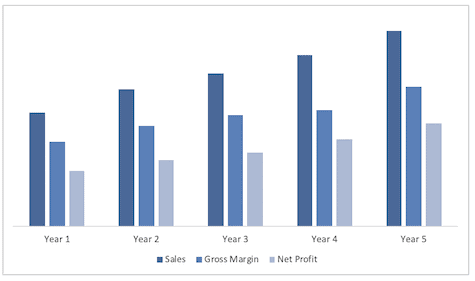
Balance Sheets
Balance sheets show your assets and liabilities. While balance sheets can include much information, try to simplify them to the key items you need to know about. For instance, if you spend $50,000 on building out your logistics business, this will not give you immediate profits. Rather it is an asset that will hopefully help you generate profits for years to come. Likewise, if a lender writes you a check for $50,000, you don’t need to pay it back immediately. Rather, that is a liability you will pay back over time.
Cash Flow Statement
Your cash flow statement will help determine how much money you need to start or grow your business, and ensure you never run out of money. What most entrepreneurs and business owners don’t realize is that you can turn a profit but run out of money and go bankrupt.
When creating your Income Statement and Balance Sheets be sure to include several of the key costs needed in starting or growing a logistics business:
- Cost of equipment and office supplies
- Payroll or salaries paid to staff
- Business insurance
- Other start-up expenses (if you’re a new business) like legal expenses, permits, computer software, and equipment
Attach your full financial projections in the appendix of your plan along with any supporting documents that make your plan more compelling. For example, you might include your office location lease or a list of intellectual property you have.
Writing a business plan for your logistics business is a worthwhile endeavor. If you follow the template above, by the time you are done, you will truly be an expert. You will understand the logistics industry, your competition, and your customers. You will develop a marketing strategy and will understand what it takes to launch and grow a successful logistics business.
Don’t you wish there was a faster, easier way to finish your Logistics business plan?
OR, Let Us Develop Your Plan For You
Since 1999, Growthink has developed business plans for thousands of companies who have gone on to achieve tremendous success. Learn about Growthink’s business plan writing services .
Other Helpful Business Plan Articles & Templates

JavaScript seems to be disabled in your browser. For the best experience on our site, be sure to turn on Javascript in your browser.
Newly Launched - AI Presentation Maker

Researched by Consultants from Top-Tier Management Companies
AI PPT Maker
Powerpoint Templates
PPT Bundles
Kpi Dashboard
Professional
Business Plans
Swot Analysis
Gantt Chart
Business Proposal
Marketing Plan
Project Management
Business Case
Business Model
Cyber Security
Business PPT
Digital Marketing
Digital Transformation
Human Resources
Product Management
Artificial Intelligence
Company Profile
Acknowledgement PPT
PPT Presentation
Reports Brochures
One Page Pitch
Interview PPT
All Categories
Top 10 Logistics Business Plan Templates with Samples and Examples (Editable Word Doc, Excel, and PDF Included)

Siranjeev Santhanam
Logistics may sound like a modern and new concept, but it has been around since ancient times when people traded goods and materials through key routes across the seas. The modern logistics business has used advanced new technologies and innovations to improve this process, making it quicker, easier, and more efficient.
The logistics business is a key ingredient within the global economic system. This industry is responsible for transporting trillions of dollars worth of goods and materials around the world every year and is crucial for the smooth and unblemished functioning of global enterprises around the world.
Companies that deal in logistics must have mastered the art of planning, regulating, and organizing the flow of goods from a specified point of origin to the destination. This incorporates a broad range of activities, from transportation to inventory management and customer service.
If you’re one such company seeking to up the game for yourself, then allow us to guide you through our premium Logistics Business Plan Template. In this blog, we will be looking at some key sections within this template, fleshing out some intricate details within all of the sections. Let’s begin!
Table of Contents
- Executive summary
- Company Overview
- Industry analysis
- Customer analysis
- Competitor analysis
- SWOT analysis
- Porter’s Framework
- Marketing plan
- Operational plan
- Financial plan
1) Executive summary
An executive summary presents a curated and brief overview of a business proposal. With our executive summary section, you can synthesize all the main ideas of your logistics business proposal, creating a list of key points to convey to the audience. This section has more subheadings incorporated into the template that allow you to go through the proposal more clearly, such as the entity and the quick pitch . Use the subsections to craft a more digestible and straightforward description of your logistics business and summarize the significant data within the proposal.
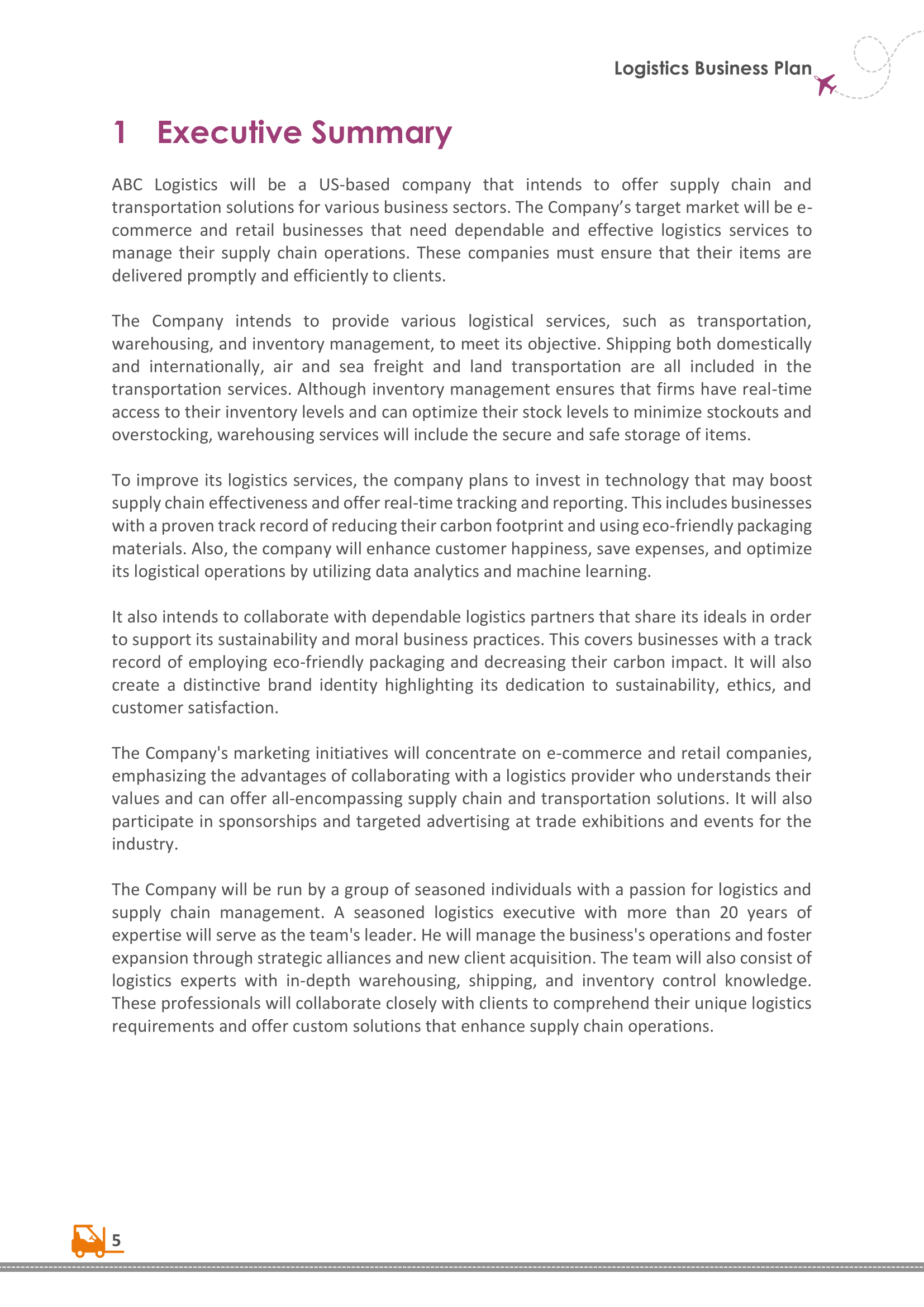
Download now
Presenting a feature-rich PowerPoint Presentation for your Logistics Business Plan, encompassing all crucial elements that leave a lasting impression on potential stakeholders.. Click here to download it now!
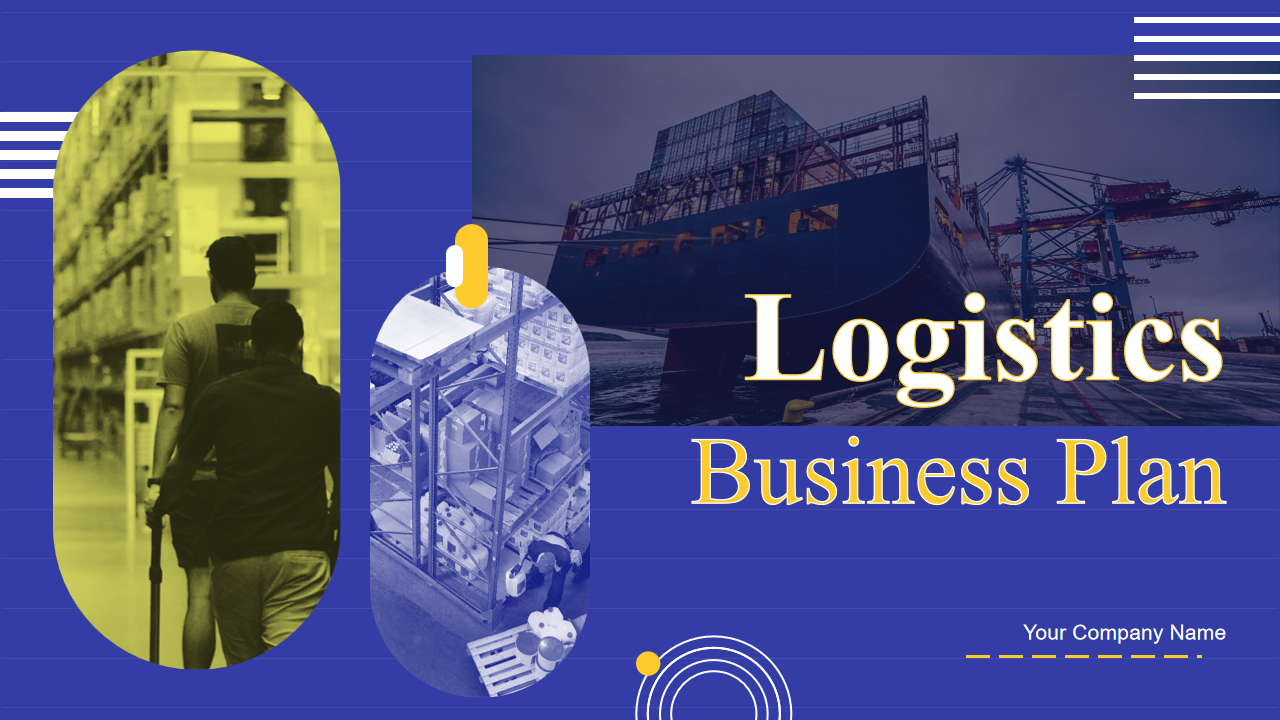
2) Company Overview
Our company overview section has been tailored to suit the logistics business. It enables you to make a substantial impact by laying out your company’s core ethos and its inherent work structure to any prospective audience. Create a stronger connection with any potential partner with the aid of this subsection, creating a more exhaustive picture of your own internal workings. Vision and mission is the first component within this section, followed by company goals and objectives . Use these two areas to establish your corporate protocols and build an aura of authenticity with the audience. Other components it includes are a start-up summary , market gap, business statement, and services offered , and you can harness them to flesh out your financial characteristics and forge your brand identity in the eyes of the investor.
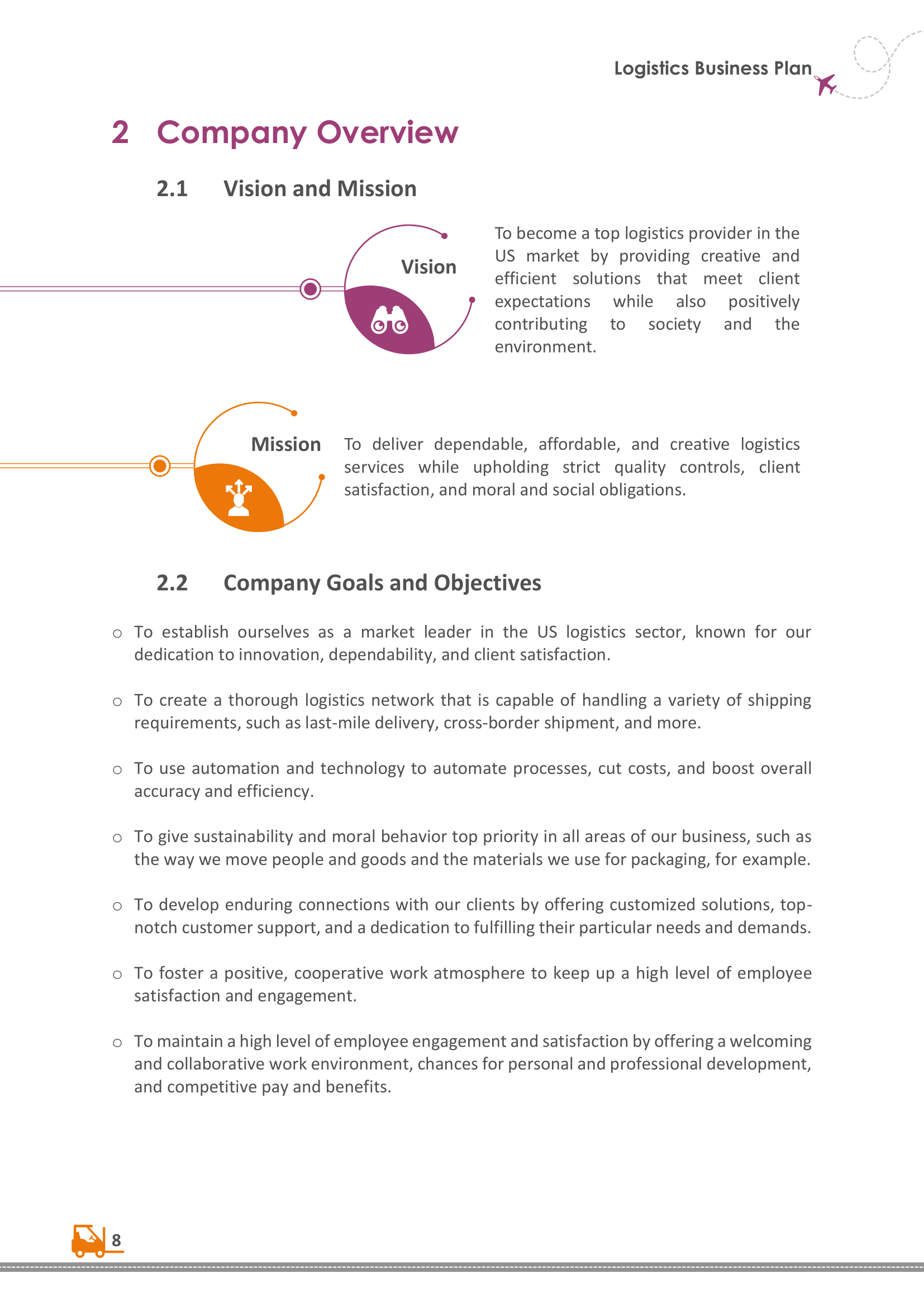
3) Industry analysis
Our industry analysis section enables you to understand the industry better, extending insight into all market areas and the prevailing currents within it. This knowledge can be crucial when establishing a presence in the logistics market, and such data-driven analysis can help a business capitalize on the most meaningful aspects of the business. Key subheadings incorporated into this document section are market analysis , market trends , major challenges, and growth drivers . Make use of the industry analysis segment to scan the scope and size of the logistics market, creating an insightful vision of the market armed with data and statistics.
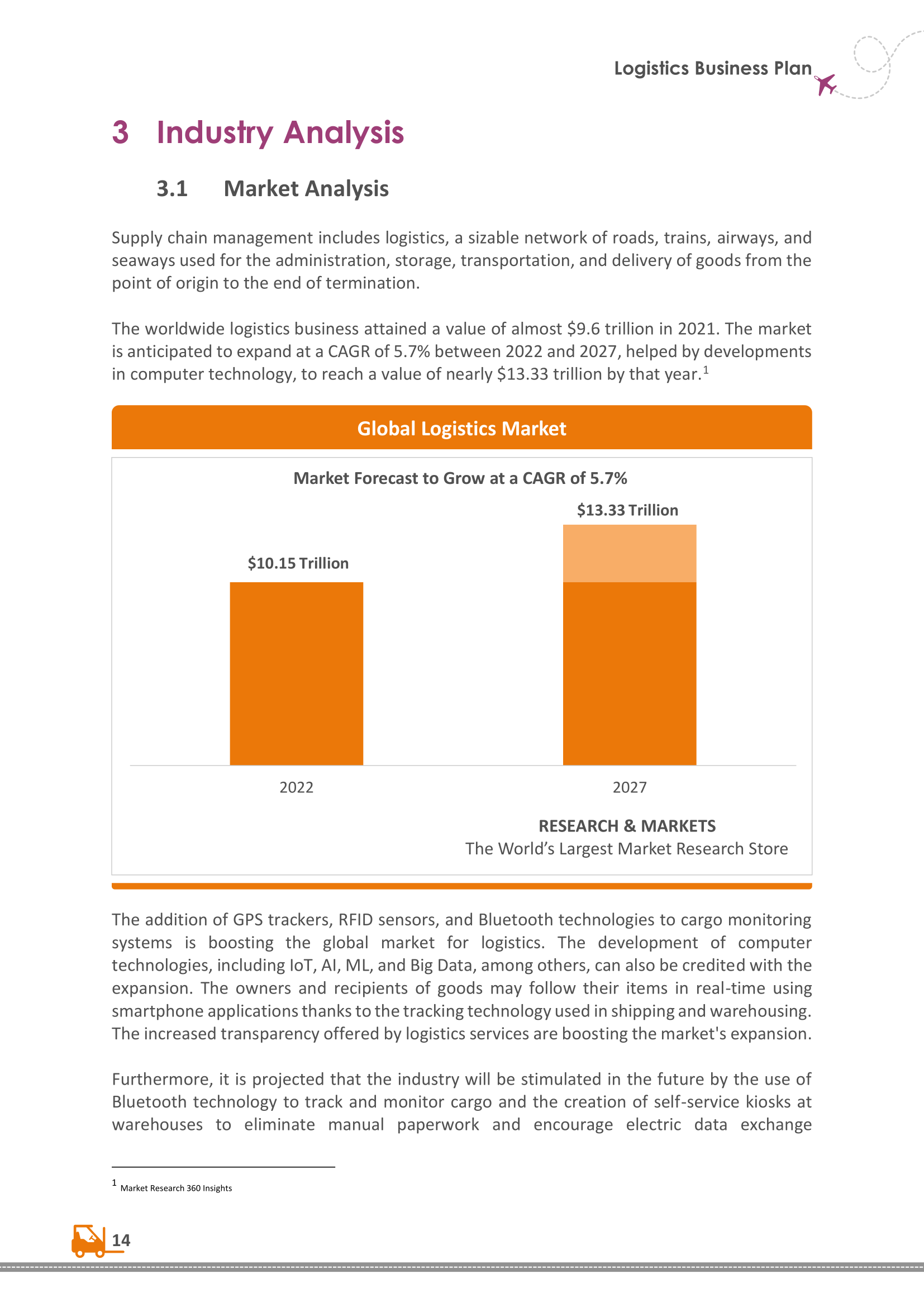
Are you looking for a resource that will help you provide a comprehensive view of your Transport and Logistics Business Plan to your audience with minimal effort? Then you must explore this one-pager PPT Template. Click here to download it.
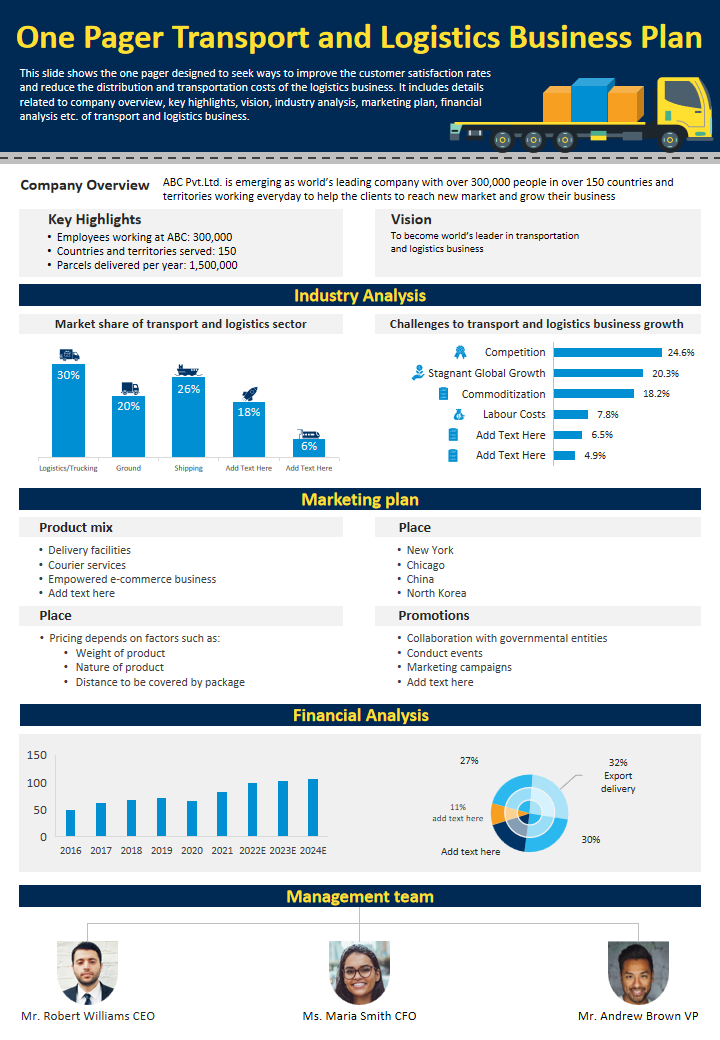
4) Customer analysis
Monitor all the crucial aspects of your target demographic, surveying their needs, preferences, and habits as you calibrate the logistics business to serve the existing demands in the market. Our customer analysis section has been tailor-made for this purpose and comes with all of the necessary vitals to help you get this done in a sound and meaningful manner. There are three major elements fitted into this section – target market , buyer’s persona, and market sizing .
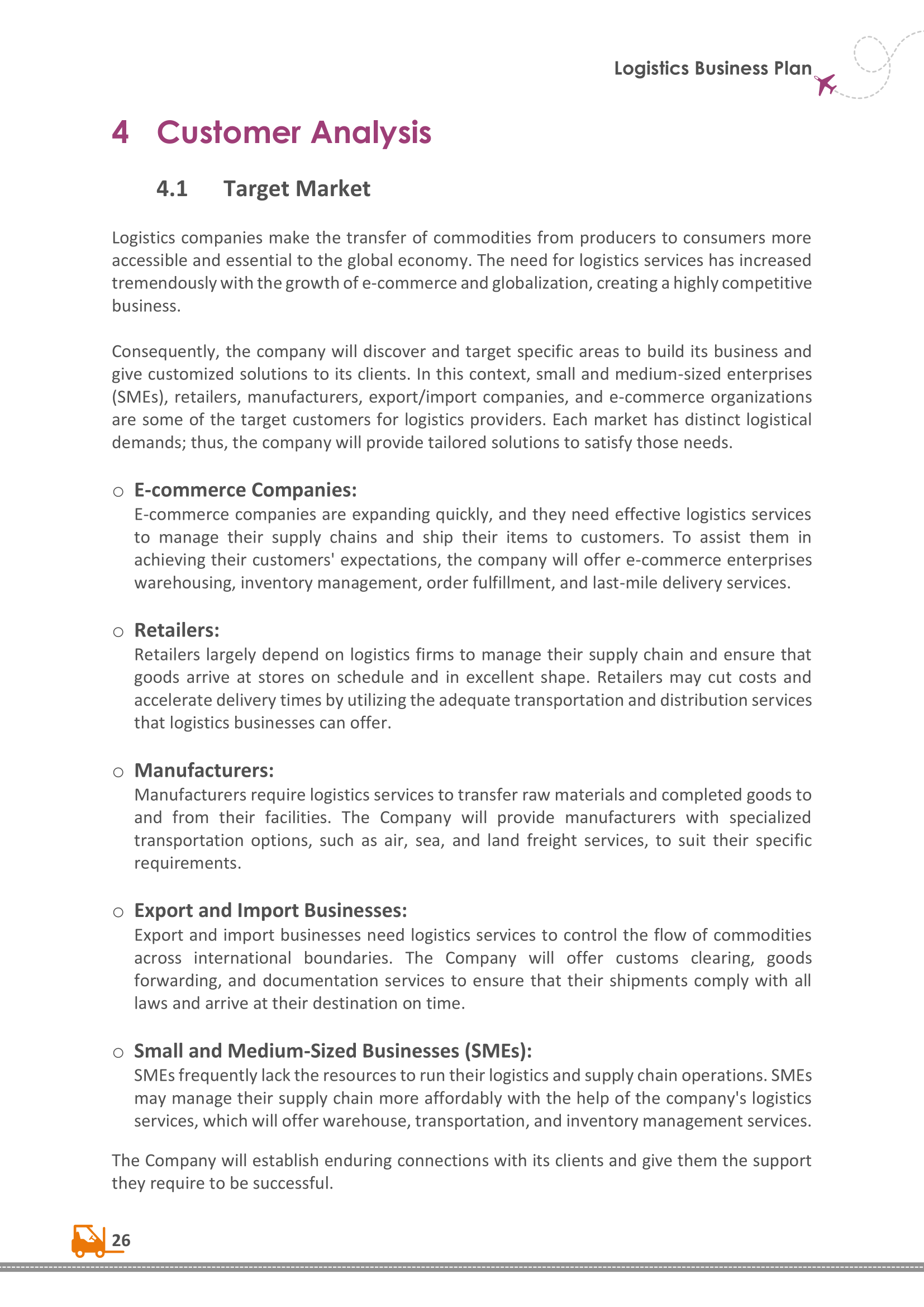
5) Competitor analysis
The competitive analysis section gives you the means to know the existing competition to create more holistic business frameworks to serve the needs of your enterprise. Achieve all this and more with the data and analytics featured within this template section. Dissect, evaluate, and scrutinize the competition, making for more sophisticated business processes that help you easily navigate the logistics market. Major players and key attributes are the key components integrated into this section.
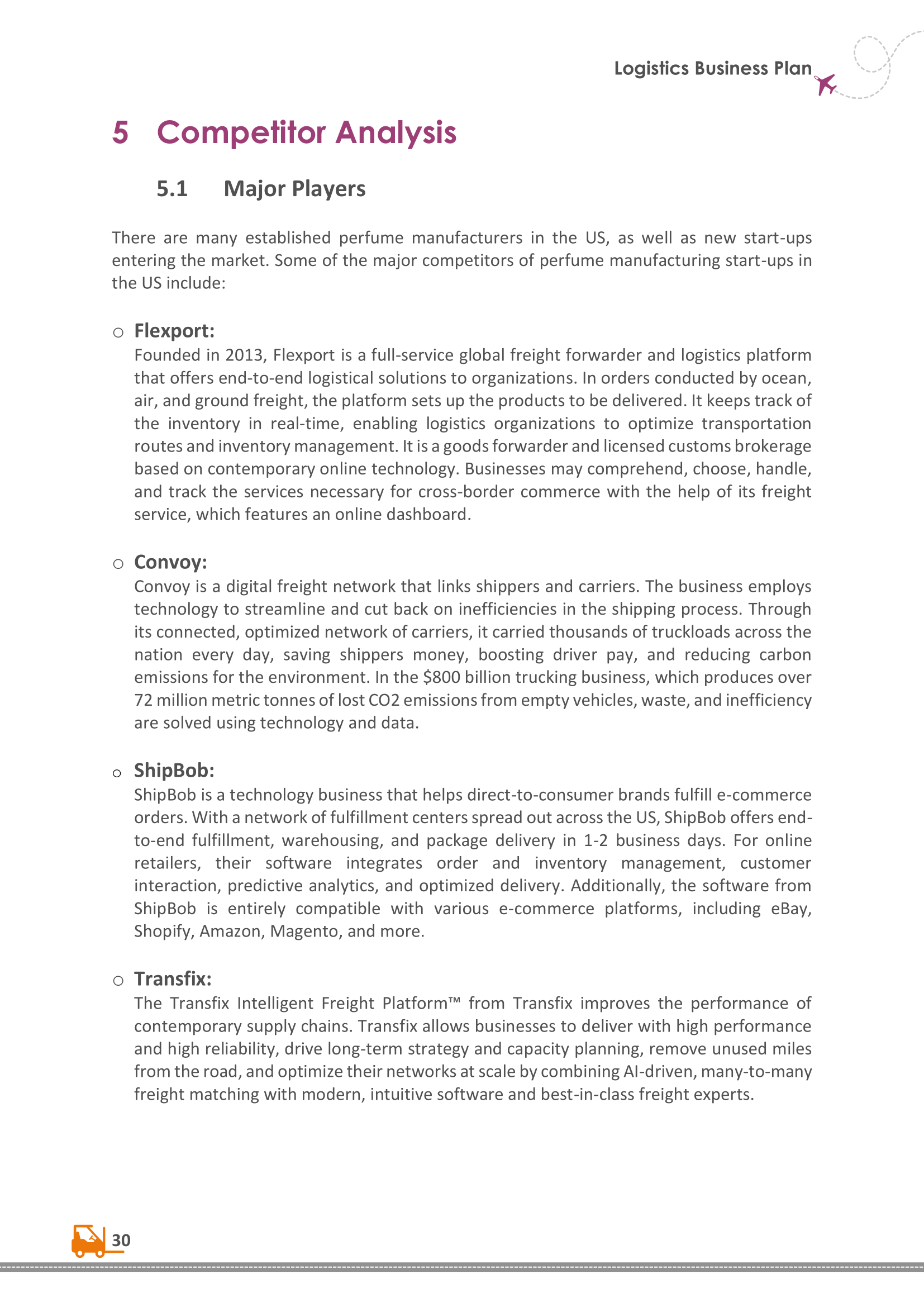
6) SWOT analysis
SWOT analysis is a stringent business methodology for assessing the health and vitality of a business enterprise and is divided into four subsections – strengths, weaknesses, opportunities, and threats. Our template has an appropriately made SWOT analysis section that can enable a strong internal evaluation of your logistics business, allowing you to screen the diverse and multifaceted aspects of the business. Use this potent analysis weapon to establish better business systems and create an environment of wholesomeness for your logistics business.
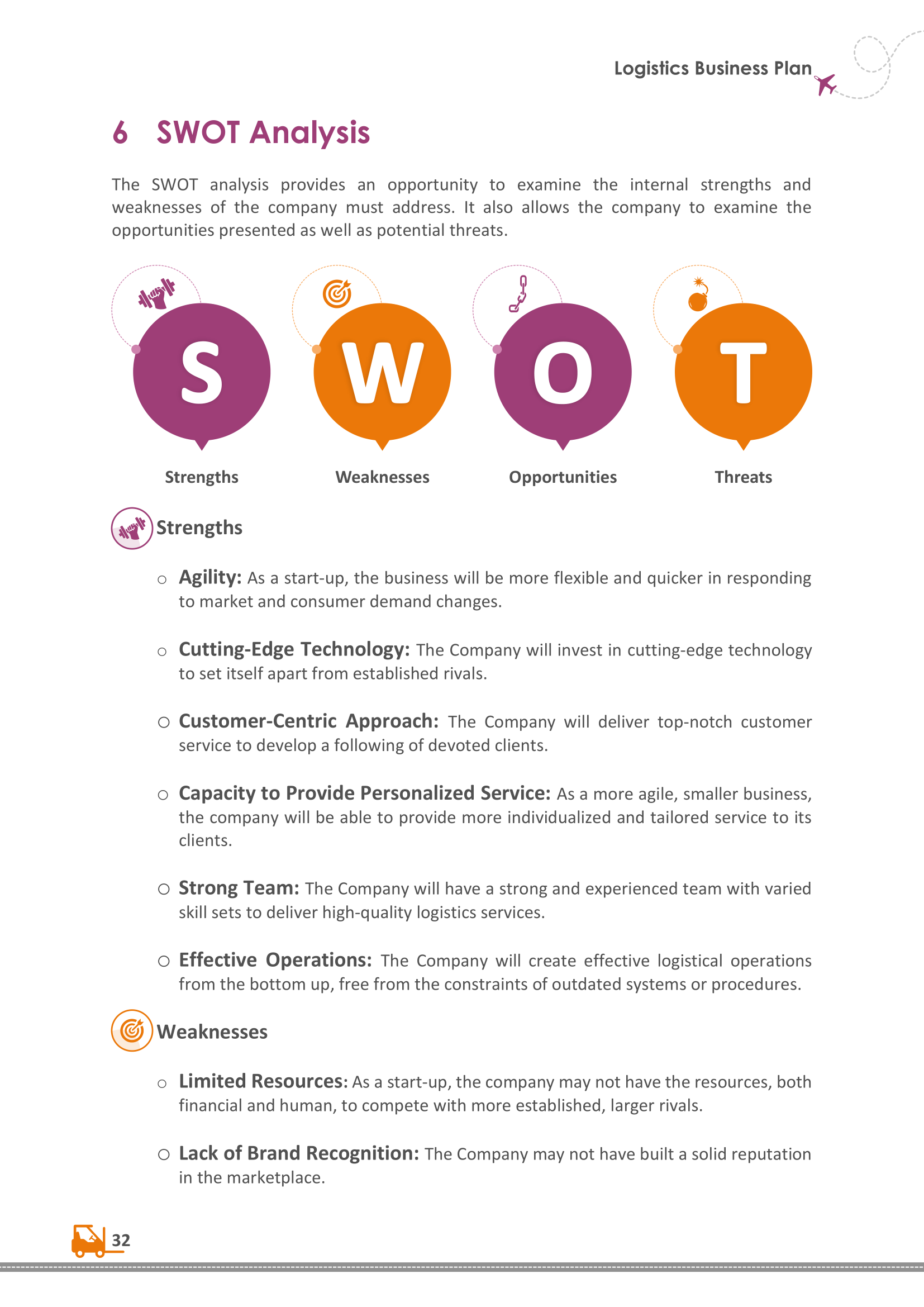
7) Porter’s Framework
Porter’s Framework Analysis is designed to carry out a multi-faceted inspection of the business to establish the potential for success. The five forces evaluated under this framework are rivalry in the industry, bargaining power of suppliers, bargaining power of buyers, threat of new entrants, and threat of substitute products. Adopt this framework and integrate its methodology into your logistics business to boost your chances of profitability and diminish resistance from the market.
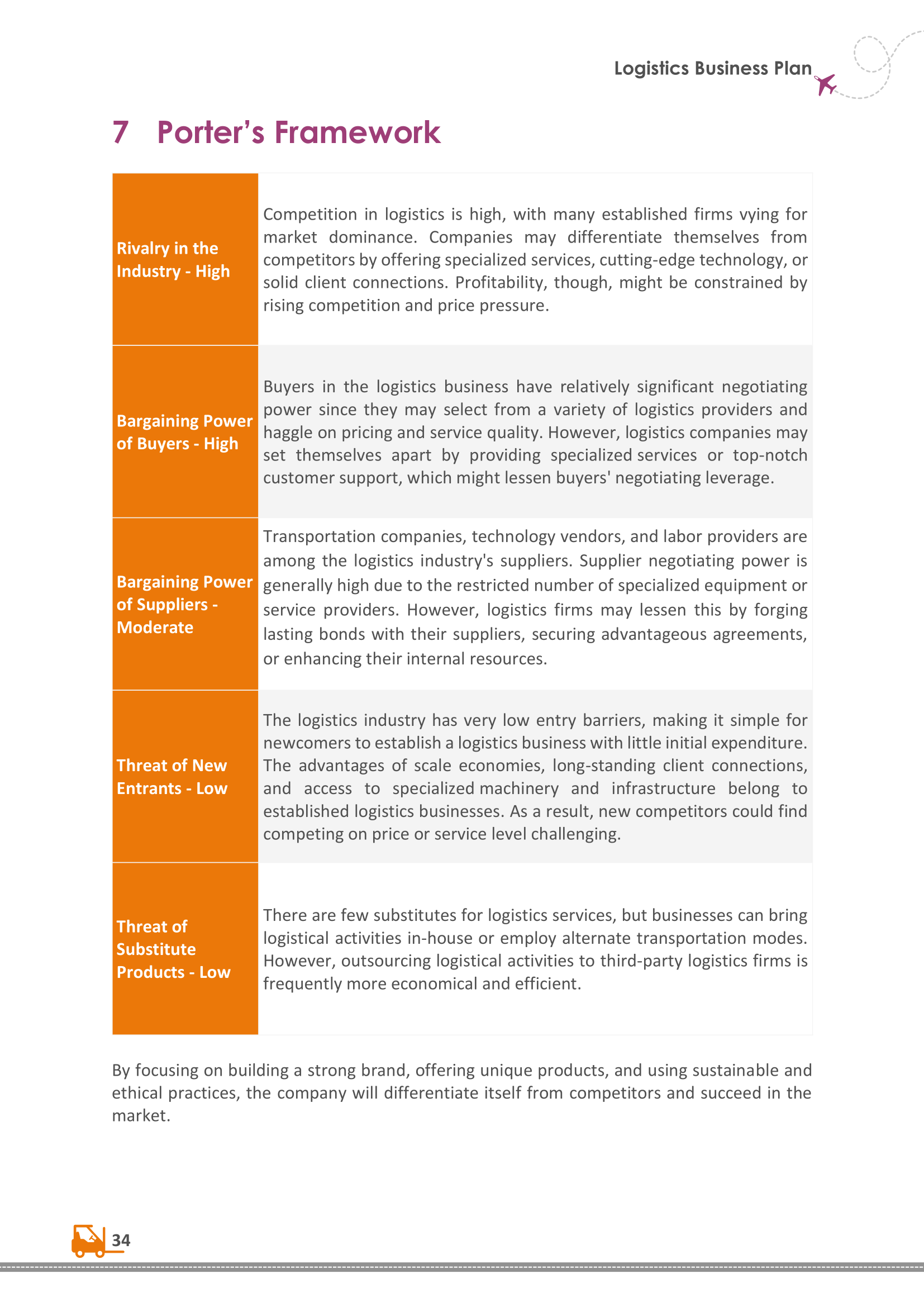
8) Marketing plan
Having a good and efficient marketing plan is a pivotal aspect of success in the world of business. With our well-designed template, you can attend to the all-encompassing demands of marketing. Subsegments included in this section are a sales strategy , a promotional strategy , a pricing strategy , and lastly, a well-laid-out sales funnel.
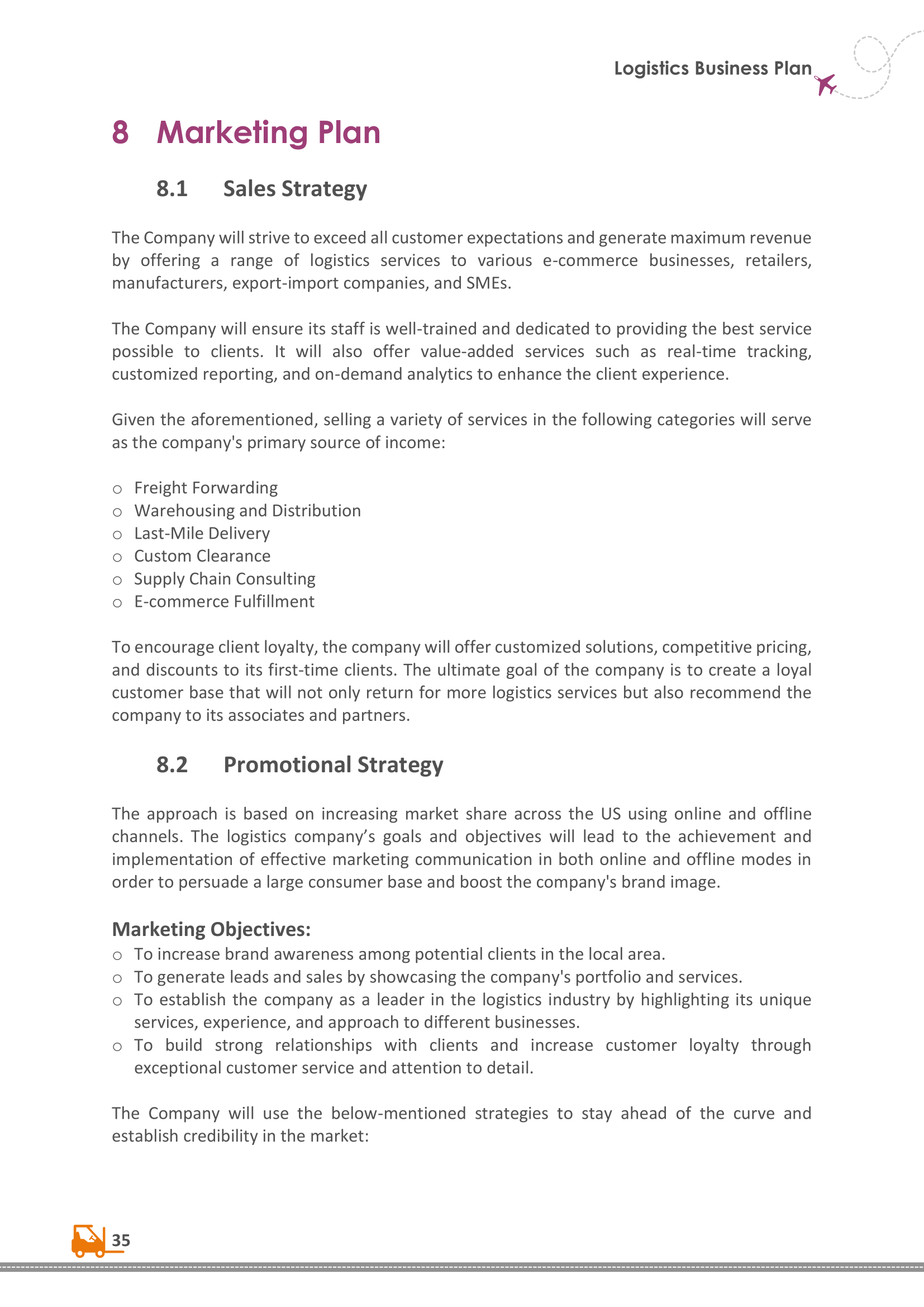
9) Operational plan
This subsection is devoted to corporate operations and assists you as you bring your firm’s operational capacities to the fullest extent. Data and information help to substantiate this, with key subheadings such as milestones , helping to create a more well-integrated operational framework for your logistics firm.
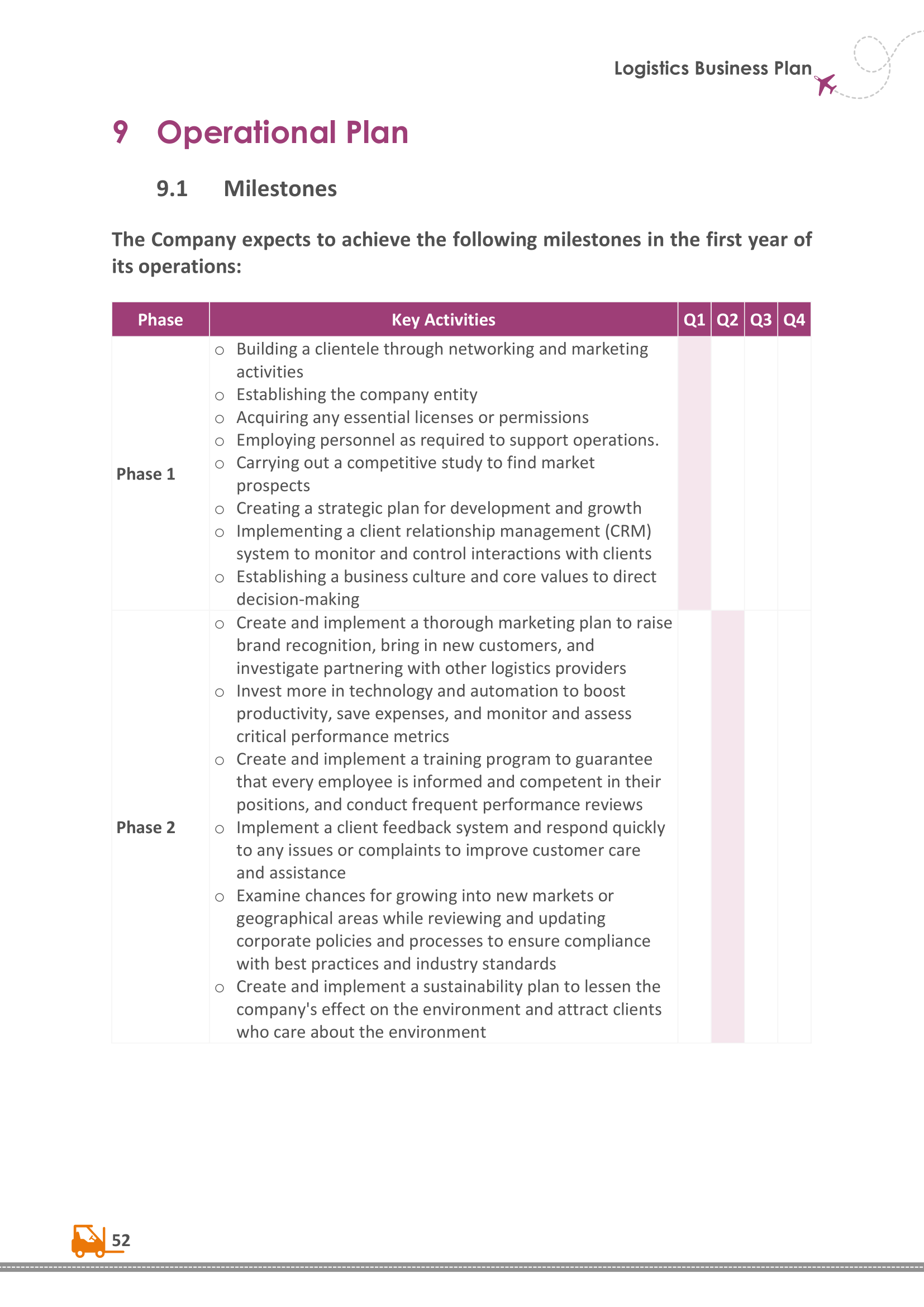
10) Financial plan
Use our financial plan section to create a more consolidated and secure financial apparatus to back your logistics operations, ensuring maximal profits in the long run. This region has many intricately laid out subsections, all designed to help unleash your full financial potency. Examples include financial assumptions , revenue model and sales forecast , breakeven analysis , projected profit and loss account, and projected cash flow statement .
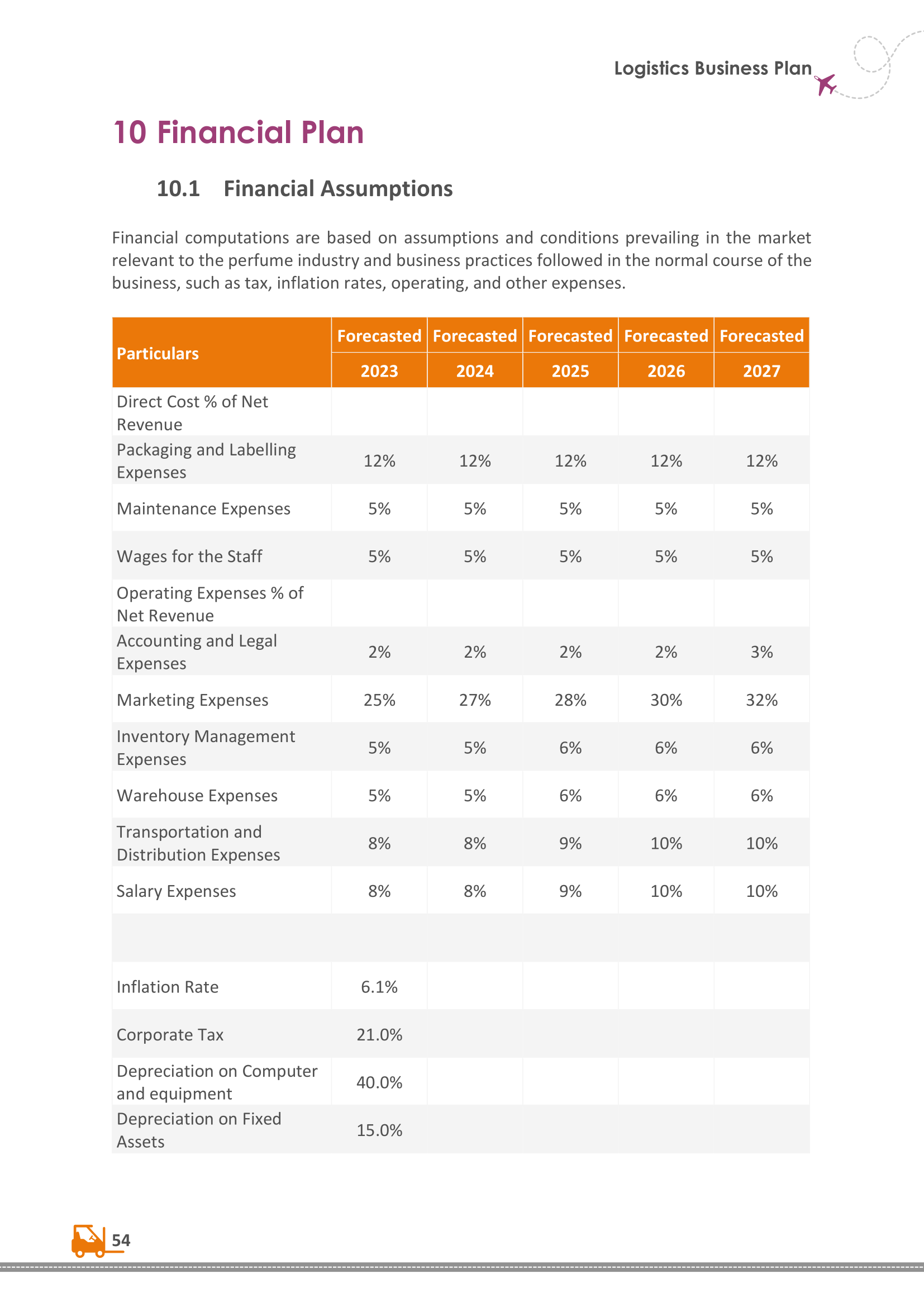
The Logistics Business Plan Template provides a comprehensive framework for planning and developing strategies for the efficient management and growth of logistics operations. It helps businesses streamline their logistics processes and make informed decisions to enhance productivity and profitability.
We have given you a small glimpse into this exhaustively made premium business plan template . Download the business plan ppt templates now and access the full breadth of the slides we’ve prepared for you, building upon the right frameworks to create a successful logistics business in the long run.
FAQs on Logistics Business Plan
What is a logistics business plan.
A logistics business plan is a proposal or a plan that expands on the goals, operational frameworks, and strategies of a logistics company that one plans to initiate. It is a guiding principle for such a company. It helps to steer the decisions of the company and its processes of resource allocation.
How do I start a logistics startup?
Below are some vital steps to starting a logistics company:
Step 1 – Establish your key business framework
Step 2 – Conduct extensive market research
Step 3 – Outline the financial and strategic goals in a business plan
Step 4 – Secure the required licenses/permits
Step 5 – Employ key individuals for the business’s infrastructure
Step 6 – Build all of the right logistical channels and market your business
How profitable is the logistics business?
The average profit margin for companies in the logistics area is around 8%. This signifies that a logistics company manages to pocket eight dollars in revenue for every hundred dollars in revenue. This means that the logistics business has a decent potential for profit, however, multiple aspects help to shape the overall revenue flow and profitability of a business in this area as well, such as the market conditions, competition, economic landscape, etc.
What are the four logistics activities?
The four major activities within the logistics domain would be procurement, warehousing, inventory management, and lastly, transportation.
Related posts:
- Top 10 Supermarket Business Plan Templates with Examples and Samples (Editable Word Doc, Excel, and PDF Included)
- Top 10 Consulting Business Plan Templates with Samples and Examples (Editable Word Doc, Excel, and PDF included)
- [Updated 2023] Top 25 One Page Business Plan PPT Templates
- Top 10 Childcare Business Plan Templates with Examples and Samples(Editable Word Doc, Excel, and PDF Included)
Liked this blog? Please recommend us

Top 10 Bar Business Plan Templates with Examples and Samples (Editable Word Doc, Excel and PDF Included)

Must-have Healthcare Quality Improvement Plan Templates with Samples and Examples
This form is protected by reCAPTCHA - the Google Privacy Policy and Terms of Service apply.


IMAGES
VIDEO